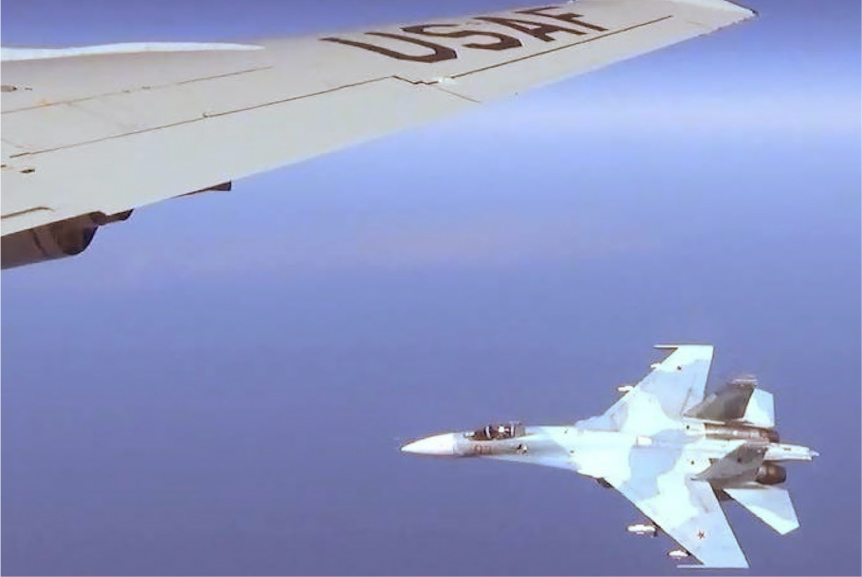
A USAF RC-135U in international airspace over the Baltic Sea is intercepted by an Su-27 on June 19. Until this point, Russian air intercepts during BALTOPS had been done safely. Photo by MSgt. Charles Larkin Sr.
Supreme Headquarters Allied Powers Europe, Mons, Belgium—Ten years ago, NATO’s strategic energy was increasingly directed south and east, toward the Black Sea, Middle East, and so-called out of area operations in Afghanistan. The alliance was consciously shifting its focus from high-end warfare toward counterinsurgency operations.
Then Vladimir Putin’s Russia repeatedly demonstrated it was really interested in being a global bully and thug. Russia is widely believed to have orchestrated cyber attacks against Estonia in 2007. It fought a short but intense war against Georgia in 2008.It illegally seized Crimea from Ukraine in 2014. It has fought a shadowy war in Ukraine since then, has effectively assumed control of Georgia’s Abkhazia and South Ossetia regions, and has deployed forces to Syria—not to battle ISIS but to prop up the murderous Assad regime.
Russia violated the Intermediate-range Nuclear Forces (INF) treaty, fired cruise missiles into Syria, and has flown military aircraft over the Baltic Sea without transponders on. These actions are intended to reassert Russian dominance on the international stage.
“We now realize we need to be training more, and be more capable, to deter aggression,” noted USAF Maj. Gen. Joseph T. Guastella Jr. in an interview at SHAPE. It is NATO’s responsibility to protect the alliance’s 29 members, and airpower is central to the response.
Many of America’s European allies have air defenses that would be simply overwhelmed by a concerted Russian attack. Some have no fighters at all.
The Russian military spent much of this summer in the news as it kept finding innovative ways to show off its military capabilities.
In June, as annual US and NATO exercises were ramping up in the Baltic region, Russian Su-27 Flankers twice intercepted USAF B-52s in international airspace. The second intercept took place while civilian and military reporters were on a photo flight aboard a nearby KC-135 during Exercise Baltic Operations (BALTOPS), ensuring plentiful news coverage.
US Air Forces in Europe Commander Gen. Tod D. Wolters said at the time that “100 percent of the intercepts … conducted by the Russians during BALTOPS were deemed safe.” Perhaps this displeased Putin.
As if on cue, Russia that same day departed the pattern. On June 19, a Flanker aggressively intercepted an Air Force RC-135U over the Baltic Sea. “Due to the high rate of closure speed and poor control of the aircraft during the intercept, this interaction was determined to be unsafe,” said US European Command. At one point, the Flanker was 10 feet from the RC-135’s wing.
Russia planned a major military exercise for September in Belarus, near NATO allies Latvia, Lithuania, and Poland. It will involve heavy armor and up to 100,000 participants. “Their actions speak loudly, and their actions are destabilizing,” said Guastella, then SHAPE’s deputy chief of staff for operations and intelligence. “The behavior is aggressive. Being a defensive alliance, we’re tracking it; we’re aware of it.”
What to do about this? Combat-ready British and Italian Typhoon fighters recently deployed to Romania and Bulgaria. These jets worked in conjunction with Romanian and Bulgarian MiGs to shore up the air defenses of those nations, adding depth to the defense. Rotational forces, especially airpower, provide diverse defensive capabilities. American participation in these sorts of European security activities is rapidly increasing.
Rotational deployments are the mechanism of choice, as they allow multiple units to improve their readiness. Airpower’s flexibility embodies this. Air Force units can (and do) deploy from the United States to fly missions out of multiple air bases in different countries. This forward presence shows Russia that NATO is ready to match it in a high-end fight.
“If an aggressor were to engage the Baltic nations, well, they’re not just engaging the Baltic nation’s defenses,” Guastella said. “Most of NATO is there as well.”
“Airpower is as relevant as it ever was in defense of this alliance,” he continued. “Airpower provides what it has provided US troops since 1953”: protection from enemy air. It also “holds targets at risk in any country, so [adversaries] know there is going to be a lot at stake, and a lot vulnerable, when US and alliance airpower can be brought to the table.”
F-35 strike fighters and all three USAF bomber types deployed to Europe for exercises this summer. USAF is significantly improving its readiness in Europe, and as it fields new equipment, this also needs to come to the continent.
The Air Force is the world’s leader in providing airpower. USAF’s tight bond with NATO may be exactly what keeps Europe safe from a Russia that has been all too willing to attack its neighbors.